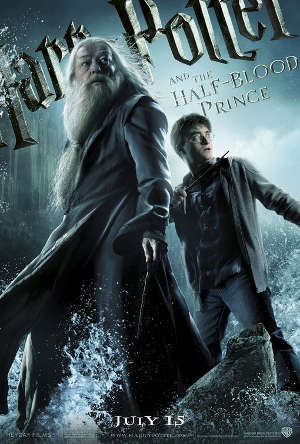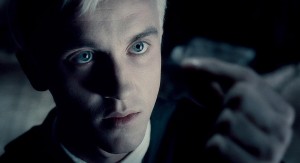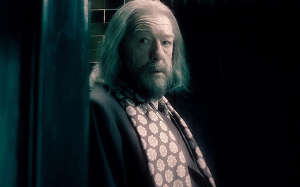- Title: Harry Potter and the Half-Blood Prince
- IMDB: link

 Being a Harry Potter fan and a film snob is not easy. Though Chris Columbus’ films were decent, the only adaptation that really worked was 2004’s The Prisoner of Azkaban. With that single concession, we the faithful have just had to sit around and take it from Warner Bros. as they haphazardly adapted the books into competent but lacking films.
Being a Harry Potter fan and a film snob is not easy. Though Chris Columbus’ films were decent, the only adaptation that really worked was 2004’s The Prisoner of Azkaban. With that single concession, we the faithful have just had to sit around and take it from Warner Bros. as they haphazardly adapted the books into competent but lacking films.
On various occasions, I admit, I day-dreamt of getting that phone call offering me the job of directing the next HP feature – which I’d nail and rock the pants off of, obviously. But having just seen The Half-Blood Prince, I’m shocked but very pleased to say that my services were not at all needed on this sixth movie.
In the film, the Wizarding world is clamping down and losing a war with the evil Lord Voldemort. Voldemort seeks power and devotion from his followers, all the while killing anyone in his way, or anyone with “impure” blood, or born to a non-magical person. But as all this is going on, there are whispers that only Harry Potter, the boy who somehow led to the downfall of the Voldemort when he was attacked as a baby, can defeat Voldemort this time around.
Preparing himself for an ultimate showdown while taking his sixth year of classes at Hogwarts, now 16-year-old Harry and his friends Hermione and Ron also have to deal with feelings of unrequited love and that asshole, Draco Malfoy.
Half-Blood Prince is helmed by David Yates, a television director who was hardly known until he took on the fifth Potter film, The Order of the Phoenix. Hearing that Yates would be back for Prince was not the best news I’d ever heard – his first stab at the Wizarding world was well-intentioned but unstable, a series of scenes that didn’t feel connected except by the mere fact that they all originated from the same book. Throw in some mediocre action, acting and some annoying photography (every scene was chock full of a barren dark blue), and you could consider me officially disappointed.
 But surprisingly, Yates almost totally changes his aesthetic for his second film in the series. It no longer feels rushed – on the contrary, the editing is dedicated to giving every exchange between the characters as much time as they need, if not a few seconds extra. I’ll even say the pacing is a almost too slow – but I’d rather spend more time than I need with these moments than not enough at all.
But surprisingly, Yates almost totally changes his aesthetic for his second film in the series. It no longer feels rushed – on the contrary, the editing is dedicated to giving every exchange between the characters as much time as they need, if not a few seconds extra. I’ll even say the pacing is a almost too slow – but I’d rather spend more time than I need with these moments than not enough at all.
It’s heartening to see Steve Kloves, whose written all but one of the Potter scripts, is more willing than ever to change up the events from the book. I’d love to see a movie that perfectly recreated everything I imagined when I read the book, but (1), it’d be impossible to cater to everyone’s ideas of the book, and (2), what’s the point when we still have the book?
Kloves and Yates have come together and reassemble the book’s events into a narrative that’s more coherent for a film, and even added some material of their own. But just because they break the literal translation from the source material doesn’t make it any less faithful to the characters or the story – this is still Harry Potter and the Half-Blood Prince, it’s just not trying to be the carbon copy that it could never be.
Unfortunately, Yates does elect to keep the same basic color scheme from his first film. The movie looks like it was all photoshoped, and it fails to interest the eyes as much as past films in the series. It’s so cold and lifeless that you find yourself hoping the bright red hair of Ron will pop up in the next frame to break up the frozen blues and greys on the screen.
 It should be mentioned, though, that the rest of the film’s cinematography is a beauty – immaculate angles, blocking and deliberate camera movement that all wordlessly tell the story, add up to a contemplative and epic but grounded look.
It should be mentioned, though, that the rest of the film’s cinematography is a beauty – immaculate angles, blocking and deliberate camera movement that all wordlessly tell the story, add up to a contemplative and epic but grounded look.
The young actors of the series have improved with each new installment of the series, and they have more to be proud of with Half-Blood Prince than ever before. Daniel Radcliffe, as Harry, still has some pretty bad moments, but he’s never wince-inducing like I’ve come to expect him. The other two leads – Rupert Grint and Emma Watson, though, really shine through. Both feel as though they’ve reached a truly proficient level of their craft. And fans of the series will be glad to discover that for the first time, they’re not just Harry’s sidekicks, but treated as characters all on their own.
I feel like, no matter how much I could know about film, coming into Harry Potter and the Half-Blood Prince as an established fan of the books is going to prevent me having the same experience as a newbie to the story might. But even having had the entire story spoiled for me in the first place, it’s hard to deny that this newest film in the franchise is ridiculously well-made, far above par for the series or any other major-budget film.
